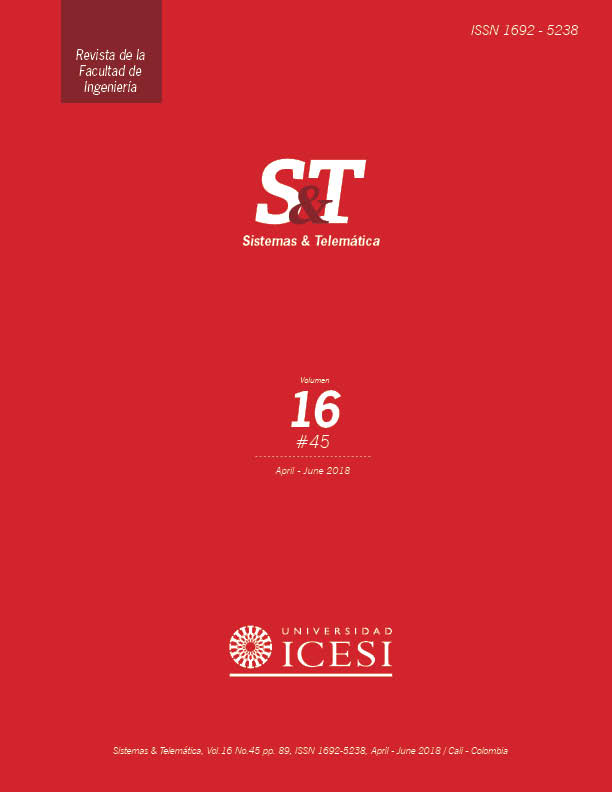Hacia ciudades más inteligentes aprovechando el paradigma de Fog Computing
DOI:
https://doi.org/10.18046/syt.v16i45.2756Palabras clave:
Niebla computacional; computación en la nube; ciudades inteligentes.Resumen
El término fog computing [computación en la niebla o niebla computacional] ha cobrado auge en los últimos años por su incidencia en la disminución de la latencia que tienen las aplicaciones de Internet de las Cosas [IoT, Internet of Things], las cuales demandan respuestas en tiempo real o cercano al real, así como por el menor consumo de ancho de banda que resulta de resolver parte del procesamiento más cerca de los dispositivos del usuario final. Ya no es suficiente el paradigma de la cloud computing [nube computacional]. En el presente, la necesidad del “dato” y de la toma de decisión al instante impulsan, o de alguna manera descubren, un horizonte nuevo que demanda de una variante complementaria. Este artículo constituye un acercamiento al término fog computing, aparejado con el análisis de su necesidad ante soluciones ingenieriles en el campo de la IoT, su impacto en las ciudades inteligentes y demás campos de acción, y algunos de susprincipales retos. Se ofrece además, una hoja de ruta para implementar un sistema de recomendación de lugares de interés al viajero basado en fog computing, en el marco de un proyecto de ciudades inteligentes en La Habana.
Referencias
Akamai Technologies. (2017). Q1 2017 State of the Internet / Connectivity Report. Retrieved from: https://www.akamai.com/us/en/multimedia/documents/state-of-the-internet/q1-2017-state-of-the-internet-connectivity-report.pdf
Arco Research Group (2017, March 12). El papel de la tecnología de lógica reconfigurable como respuesta a los retos del Internet de las Cosas. Retrieved from: https://arcoresearchgroup.wordpress.com/2017/03/12/el-papel-de-la-tecnologia-de-logica-reconfigurable-como-respuesta-a-los-retos-del-internet-de-las-cosas/
Bojanova, I. (2015). What makes up the Internet of Things? Retrieved from: https://www.computer.org/web/sensing-iot/content?g=53926943&type=article&urlTitle=what-are-the-components-of-iot-
Bonomi,F., Milito, R., Zhu, J., & Addepalli, S. (2012). Fog computing and its role in the Internet of Things. In: Proceedings of the first edition of the MCC Workshop on Mobile Cloud Computing, (pp. 13-16). New York, NY: ACM.
Cardellini, V., Grassi, V., Lo Presti, F., Nardelli, M. (2015). On QoS-aware Scheduling of Data Stream Applications over Fog Computing Infrastructures. In: 2015 IEEE Symposium on Computers and Communication (ISCC), (pp. 271-276). doi:10.1109/ISCC.2015.7405527
Cisco Systems. (2017). Fog computing and the Internet of things: Extend the cloud to where the things are [white paper]. Retrieved from: https://www.cisco.com/c/dam/en_us/solutions/trends/iot/docs/computing-overview.pdf
De Fuenmayor, A. (2017, Feb. 20). Cloud computing, ¿el final de una era? [blog ThinkingBig]. Retrieved from: https://aunclicdelastic.blogthinkbig.com/cloud-computing-iot/
Gonzalez, G., Delgado, T., Capote, J. L., & Cruz, R. (2013). Context-aware recommender system based on ontologies. In: H. Onsrud, & A. Rajabifard (Eds.), Spatially enablement in support of economic development and poverty reduction, (pp. 227-243). Reston, VA: GSDI.
Gupta, H., Vahid-Dastjerdi, A., Ghosh, S.K., Buyya, R. (2017). FogSim: A toolkit for modeling and simulation of resource management techniques in internet of things, edge and fog computing environments. Software: Practice and Experience, 47(9), 1275-1296.
Hu, P., Dhelim, S., Ning, H. Qiu, T. (2017). Survey on fog computing: Architecture, key technologies, applications and open issues. Journal of Network and Computer Applications, 98, 27-42.
International Telecommunications Union [ITU]. (25/ 4/2017). The Manizales Manifesto. Retrieved from: https://www.itu.int/en/ITU-T/Workshops-and-Seminars/gsw/201704/Documents/Manifesto-Manizales-05-04-2017-Eng-Final.pdf
Lai, C. F., Song, D. Y., Hwang, R. H., & Lai, Y. X. (2016). A QoS-aware streaming service over fog computing infrastructures. In Digital Media Industry & Academic Forum (DMIAF), (pp. 94-98). IEEE.
Mapped: The world according to Internet connection speeds - Telegraph (2017, April, 9). Retrieved from: http://www.telegraph.co.uk/travel/maps-and-graphics/countries-with-fastest-internet-connection-speeds/
Mohamed, N., Al-Jaroodi, J., Jawhar, I., Lazarova-Molnar, S., & Mahmoud, S. (2017). Smartcityware: A service-oriented middleware for cloud and fog enabled smart city services. IEEE Acces, 5, 17576-17588. doi:r 10.1109/ACCESS.2017.2731382
Varshney, P., & Simmhan, Y. (2017). Demystifying fog computing: Characterizing architectures, applications and abstractions. In Fog and Edge Computing (ICFEC), 2017 IEEE 1st International Conference on (pp. 115-124). IEEE.
Yousefpour, A., Ishigaki, G., & Jue, J. P. (2017). Fog computing: Towards minimizing delay in the internet of things. In Edge Computing (EDGE), 2017 IEEE International Conference on (pp. 17-24). IEEE.
Descargas
Publicado
Número
Sección
Licencia
Esta publicación está licenciada bajo los términos de la licencia CC BY 4.0 (https://creativecommons.org/licenses/by/4.0/deed.es)



